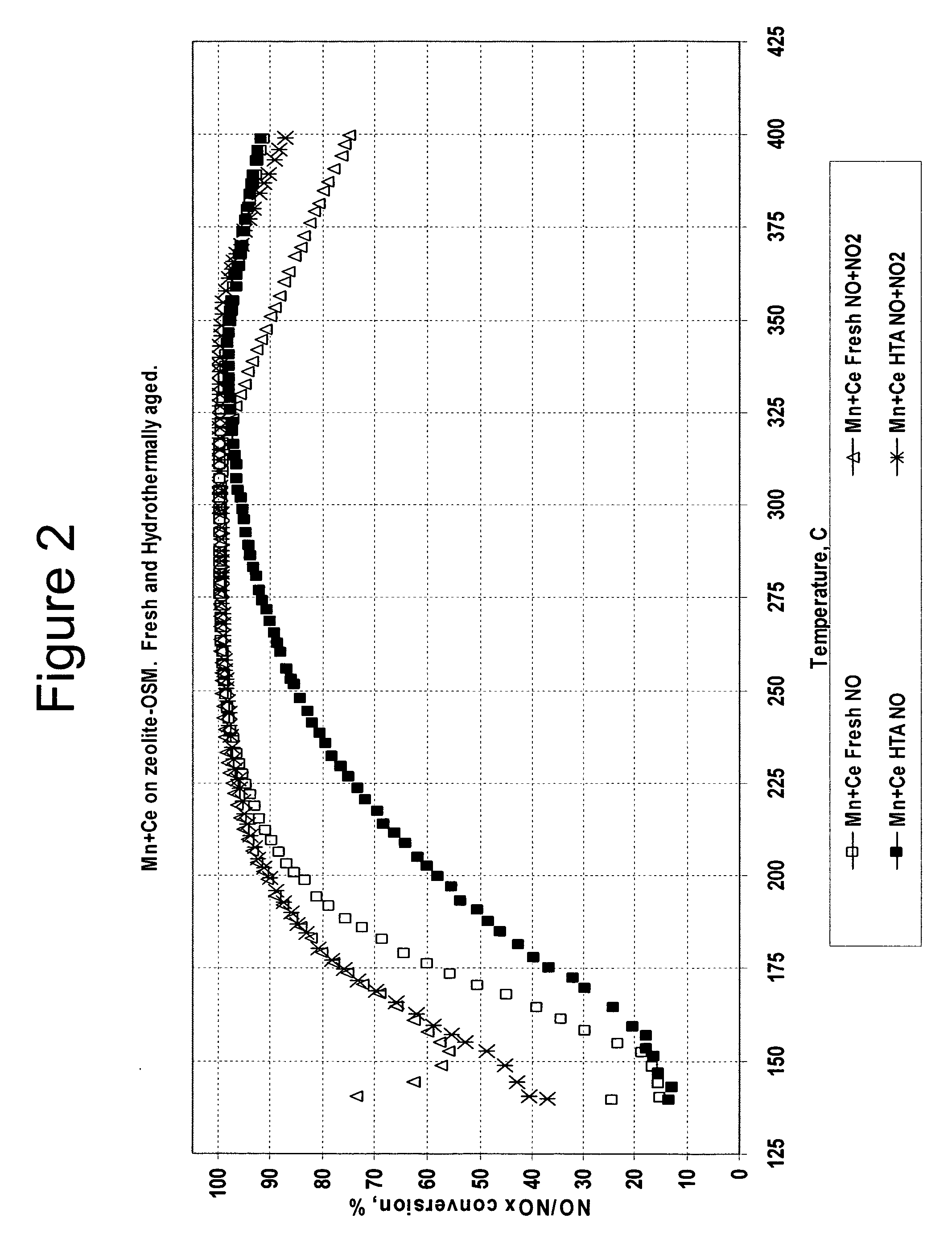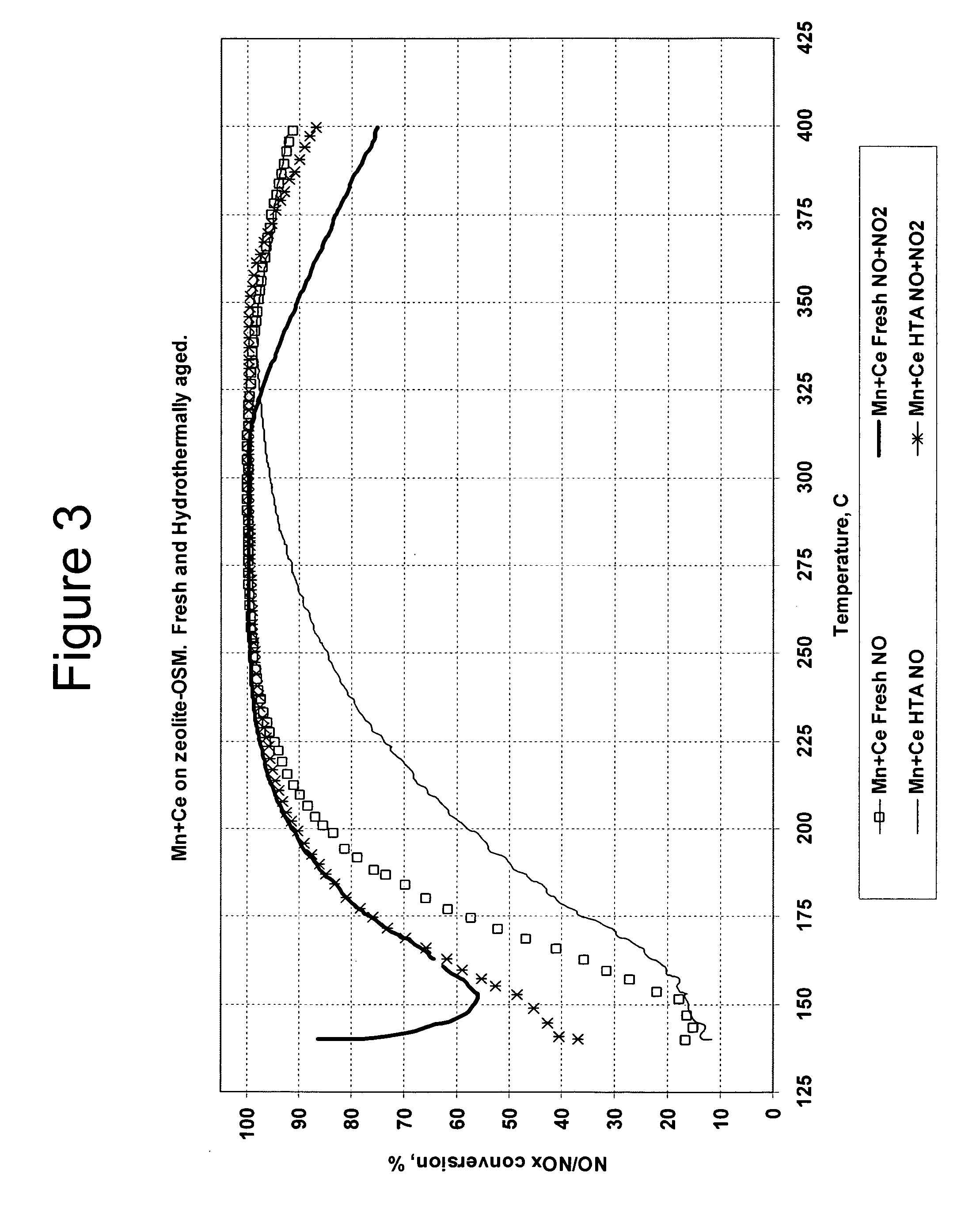Ammonia SCR catalyst and method of using the catalyst
a technology of ammonia scr catalyst and catalyst, which is applied in the direction of catalyst regeneration/reactivation, physical/chemical process catalyst, separation process, etc., can solve the problems of significant nitrogen oxide and particulate emissions of diesel-fueled vehicles, and significant deactivation of copper catalyst in the age of tim
- Summary
- Abstract
- Description
- Claims
- Application Information
AI Technical Summary
Benefits of technology
Problems solved by technology
Method used
Image
Examples
example 1
Synergy Between a Manganese First Component and a Cerium Second Component
[0072]The catalysts with the compositions shown in Table 1 were prepared and tested for ammonia SCR reduction of nitrogen oxides. The weight percentages of manganese and cerium are given on the basis of both the oxide and the metal, where the weight percentages on the basis of the metal are in parentheses in the Table.
TABLE 1Compositions of Mn and Ce CatalystsCatalystWt % Mn2O3Wt % CeO2No.(Mn)(Ce)Wt % ZeoliteWt % OSM18.8 (6.1)045.645.62013.5 (11)43.2543.2537.7 (5.4)12.3 (10)4040
[0073]The zeolite and OSM were placed on the substrate as a washcoat at a loading of about 150 g / L. The washcoat was dried at room temperature and then calcined at 550° C. for 4 hours. Aqueous solutions of manganese nitrate and cerium nitrate were combined and impregnated into the washcoat on the substrate. The catalysts were dried and calcined at 550° C. for 2 hours
[0074]The catalysts in Table 1 were tested as fresh catalysts and after ...
example 2
Effects of NO and NO / NO2 Feed Gases on Iron Beta SCR Activity
[0080]Iron-exchanged zeolite beta was supplied by Tricat GmbH, Bitterfeld, Germany.
[0081]Catalyst 4, with the composition shown in Table 2, was prepared with the iron-exchanged Beta zeolite.
TABLE 2Composition of Iron-Exchanged Beta CatalystWt % Iron-exchanged zeoliteCatalyst No.betaWt % OSM45050
[0082]Catalyst 4 was tested as a fresh catalyst and after hydrothermal aging with two different feed gases. The first feed gas contained 350 ppm NO with no NO2. The second feed gas contained a mixture of 175 ppm NO and 175 ppm NO2. Plots of NO / NOx conversion versus temperature for both feed gases are shown in FIG. 2.
[0083]Hydrothermal aging had little effect on the activity of Catalyst 4 with either the mixed NO / NO2 feed gas or the feed gas that contained only NO. The activities of both the fresh and the hydrothermally aged Catalyst 4 with the feed gas that contained NO but no NO2 were far lower than the catalyst activities with the...
example 3
Effects of NO and NO / NO2 Feed Gases on Mn / Ce / Zeolite / OSM Catalyst Activity
[0084]Catalyst 3, the Mn / Ce / zeolite / OSM catalyst, a catalyst according to an embodiment of the present invention, was tested for SCR activity in Example 3 with NO and NO / NO2 feed streams in the same manner as was the Fe / Zeolite beta catalyst, Catalyst 4, in Example 2. The catalyst was tested as a fresh catalyst and after hydrothermal aging. The results are shown graphically in FIG. 43.
[0085]The NOx conversion activities for the fresh and hydrothermally aged Catalyst 3 with the mixed NO / NO2 feed gas were essentially the same.
[0086]The NO conversions of the fresh and hydrothermally aged Mn / Ce catalyst with the feed stream that contained NO but no NO2 were lower than the corresponding activities with the mixed NO / NO2 feed stream. However, the conversion differences between the mixed NO / NO2 feed stream and the pure NO feed stream for the Mn / Ce / zeolite / OSM catalyst, Catalyst 3, were not nearly as great as for the F...
PUM
| Property | Measurement | Unit |
|---|---|---|
| Percent by mass | aaaaa | aaaaa |
| Percent by mass | aaaaa | aaaaa |
| Percent by mass | aaaaa | aaaaa |
Abstract
Description
Claims
Application Information
 Login to View More
Login to View More - R&D
- Intellectual Property
- Life Sciences
- Materials
- Tech Scout
- Unparalleled Data Quality
- Higher Quality Content
- 60% Fewer Hallucinations
Browse by: Latest US Patents, China's latest patents, Technical Efficacy Thesaurus, Application Domain, Technology Topic, Popular Technical Reports.
© 2025 PatSnap. All rights reserved.Legal|Privacy policy|Modern Slavery Act Transparency Statement|Sitemap|About US| Contact US: help@patsnap.com



